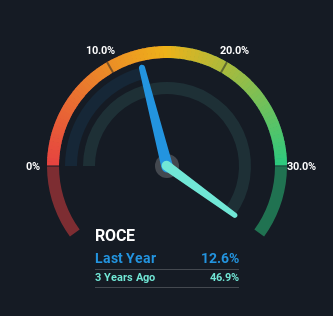- Hong Kong
- /
- Auto Components
- /
- SEHK:2457
Investors Could Be Concerned With Buyang International Holding's (HKG:2457) Returns On Capital

If you're looking for a multi-bagger, there's a few things to keep an eye out for. One common approach is to try and find a company with returns on capital employed (ROCE) that are increasing, in conjunction with a growing amount of capital employed. Put simply, these types of businesses are compounding machines, meaning they are continually reinvesting their earnings at ever-higher rates of return. Although, when we looked at Buyang International Holding (HKG:2457), it didn't seem to tick all of these boxes.
Return On Capital Employed (ROCE): What Is It?
For those that aren't sure what ROCE is, it measures the amount of pre-tax profits a company can generate from the capital employed in its business. Analysts use this formula to calculate it for Buyang International Holding:
Return on Capital Employed = Earnings Before Interest and Tax (EBIT) ÷ (Total Assets - Current Liabilities)
0.13 = CN¥49m ÷ (CN¥477m - CN¥85m) (Based on the trailing twelve months to June 2023).
Thus, Buyang International Holding has an ROCE of 13%. On its own, that's a standard return, however it's much better than the 7.5% generated by the Auto Components industry.
See our latest analysis for Buyang International Holding

Historical performance is a great place to start when researching a stock so above you can see the gauge for Buyang International Holding's ROCE against it's prior returns. If you're interested in investigating Buyang International Holding's past further, check out this free graph of past earnings, revenue and cash flow.
The Trend Of ROCE
In terms of Buyang International Holding's historical ROCE movements, the trend isn't fantastic. Around three years ago the returns on capital were 47%, but since then they've fallen to 13%. Meanwhile, the business is utilizing more capital but this hasn't moved the needle much in terms of sales in the past 12 months, so this could reflect longer term investments. It may take some time before the company starts to see any change in earnings from these investments.
On a side note, Buyang International Holding has done well to pay down its current liabilities to 18% of total assets. That could partly explain why the ROCE has dropped. Effectively this means their suppliers or short-term creditors are funding less of the business, which reduces some elements of risk. Some would claim this reduces the business' efficiency at generating ROCE since it is now funding more of the operations with its own money.
The Bottom Line On Buyang International Holding's ROCE
Bringing it all together, while we're somewhat encouraged by Buyang International Holding's reinvestment in its own business, we're aware that returns are shrinking. And in the last year, the stock has given away 30% so the market doesn't look too hopeful on these trends strengthening any time soon. All in all, the inherent trends aren't typical of multi-baggers, so if that's what you're after, we think you might have more luck elsewhere.
One more thing to note, we've identified 1 warning sign with Buyang International Holding and understanding it should be part of your investment process.
While Buyang International Holding isn't earning the highest return, check out this free list of companies that are earning high returns on equity with solid balance sheets.
Valuation is complex, but we're here to simplify it.
Discover if Buyang International Holding might be undervalued or overvalued with our detailed analysis, featuring fair value estimates, potential risks, dividends, insider trades, and its financial condition.
Access Free AnalysisHave feedback on this article? Concerned about the content? Get in touch with us directly. Alternatively, email editorial-team (at) simplywallst.com.
This article by Simply Wall St is general in nature. We provide commentary based on historical data and analyst forecasts only using an unbiased methodology and our articles are not intended to be financial advice. It does not constitute a recommendation to buy or sell any stock, and does not take account of your objectives, or your financial situation. We aim to bring you long-term focused analysis driven by fundamental data. Note that our analysis may not factor in the latest price-sensitive company announcements or qualitative material. Simply Wall St has no position in any stocks mentioned.
About SEHK:2457
Buyang International Holding
An investment holding company, engages in the research and development, design, production, and sale of aluminum alloy automobile wheels in Asia, Europe, the United States, Africa, and Oceania.
Flawless balance sheet and slightly overvalued.


